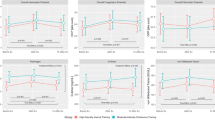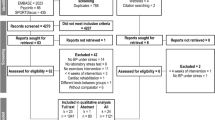Abstract
This study assessed the effect of a short-term, 8-week exercise programme on resting and exercise blood pressure (systolic (SBP); diastolic (DBP)), and other haemodynamic responses (heart rate (HR), pulse pressure (PP), double product (DP)), of newly diagnosed transient ischaemic attack (TIA) patients. Sixty-eight TIA patients completed a continuous and incremental exercise test within 2 weeks of symptom diagnosis. HR, SBP and DBP were regularly measured at rest, during exercise and in recovery. Participants were then randomised to either an 8-week exercise programme or to a usual care control group prior to completing an identical post-intervention (PI) re-assessment. Individuals randomised to the exercise condition experienced a significantly greater reduction in resting HR (−5.4±10.2%), SBP (−6.7±8.1%) and DBP (−2.8±7.2%) than the control group at the PI assessment (all P<0.05). Similar findings were demonstrated at the PI assessment when comparing haemodynamic responses during exercise (P<0.05), with significantly larger decrements observed for SBP and HR (both 10–14%), PP (17–24%) and DP (26–32%) for those randomised to the exercise intervention (all P<0.05). This study demonstrates that structured physical activity soon after TIA diagnosis will improve haemodynamic responses. The early implementation of exercise following TIA diagnosis may be an important secondary prevention strategy for this population.
This is a preview of subscription content, access via your institution
Access options
Subscribe to this journal
Receive 12 digital issues and online access to articles
$119.00 per year
only $9.92 per issue
Buy this article
- Purchase on Springer Link
- Instant access to full article PDF
Prices may be subject to local taxes which are calculated during checkout


Similar content being viewed by others
References
Alwan A, Armstrong T, Bettcher D, Branca F, Chisholm D, Ezzati M et alGlobal status report on noncommunicable diseases 2010. World Health Organization 2010.
ACSM’s Guidelines for Exercise Testing and Prescription 8th edn. Lippincott, Williams and Wilkins: Philadelphia, 2010.
Sare G, Geeganage C, Bath P . High blood pressure in acute ischaemic stroke-broadening therapeutic horizons. Cerebrovasc Dis 2009; 27: 156–161.
Pickering T, Hall J, Appel L, Falkner B, Graves J, Hill M . Recommendations for blood pressure measurement in humans and experimental animals: part 1: blood pressure measurement in humans: a statement for professionals from the subcommittee of professional and public education of the American Heart Association Council on high blood pressure research. Circulation 2005; 111: 697–716.
Chobanian A, Bakris G, Black H, Cushman W, Green L, Izzo J et al. Joint national committee on prevention, detection, evaluation, and treatment of high blood pressure, national heart, lung, and blood institute, national high blood pressure education program coordinating committee. Seventh report of the joint national committee on prevention, detection, evaluation, and treatment of high blood pressure. Hypertension 2003; 42: 1206–1252.
Vemmos K, Tsivgoulis G, Spengos K, Manios E, Daffertshofer M, Kotsis V et al. Pulse pressure in acute stroke is an independent predictor of long-term mortality. Cerebrovasc Dis 2004; 18: 30–36.
Robinson T, Dawson S, Ahmed U, Manktelow B, Fotherby M, Potter J . Twenty-four hour systolic blood pressure predicts long-term mortality following acute stroke. J Hypertens 2001; 19: 2127–2134.
Christensen H, Fogh-Christensen A, Boysen G . Abnormalities on ECG and telemetry predict stroke outcome at 3 months. J Neurol Sci 2005; 234: 99–103.
Sprigg N, Gray L, Bath P, Boysen G, De Deyn P, Friis P et al. Relationship between outcome and baseline blood pressure and other haemodynamic mreasures in acute ischaemic stroke: Data from the TAIST trial. J Hypertens 2006; 24: 1413–1417.
Lennon O, Carey A, Gaffney N, Stephenson J, Blake C . A pilot randomized controlled trial to evaluate the benefit of the cardiac rehabilitation paradigm for the non-acute ischaemic stroke population. Clin Rehabil 2008; 22: 125–133.
Wenger N . Current status of cardiac rehabilitation. J Am Coll Cardiol 2008; 51: 1619–1631.
Taylor R, Brown A, Ebrahim S, Joliffe J . Exercise-based rehabilitation for patients with coronary heart disease: systematic review and meta-analysis of randomized controlled trials. Am J Med 2004; 116: 682–692.
Wolf PA, Clagett GP, Easton JD, Goldstein LB, Gorelick PB, Kelly-Hayes M et al. Preventing ischemic stroke in patients with prior stroke and transient ischemic attack. Stroke 1999; 30: 1991–1994.
Myers J, Prakash M, Froelicher V, Do D, Partington S, Atwood JE . Exercise Capacity and mortality among men referred for exercise testing. New Engl J Med 2002; 346: 793–801.
Furie KL, Kasner SE, Adams RJ, Albers GW, Bush RL, Fagan SC et al. Guidelines for the prevention of stroke in patients with stroke or transient ischemic attack. Stroke 2010; 42: 227–276.
Lalouz P, Lemmonier F, Jamart J . Risk factors and treatment of stroke at the time of recurrence. Acta Neurol Belg 2010; 110: 299–302.
Halbert J, Silagy C, Finucane P, Withers R, Hamdorf P, Andrews G . The effectiveness of exercise training in lowering blood pressure: a meta-analysis of randomised controlled trials of 4 weeks or longer. J Hum Hypertens 1997; 11: 641–649.
Horer S, Schulte-Altedorneburg G, Haberl RL . Management of patients with transient ischemic attack is safe in an outpatient clinic based on rapid diagnosis and risk stratification. Cerebrovasc Dis 2011; 32: 504–510.
Prior PL, Hachinski V, Unsworth K, Chan R, Mytka S, O’Callaghan C et al. Comprehensive cardiac rehabilitation for secondary prevention after transient ischemic attack or mild stroke: I: feasibility and risk factors. Stroke 2011; 42: 3207–3213.
Domanski M, Mitchell G, Pfeffer M, Neaton JD, Norman J, Svendsen K et al. Pulse pressure and cardiovascular disease related mortality: follow-up study of the multiple risk factor intervention trial (MRFIT). JAMA 2002; 287: 2677–2683.
Franklin SS, Khan SA, Wong ND, Larson MG, Levy D . Is pulse pressure useful in predicting risk for coronary heart disease? Circulation 1999; 100: 354–360.
Blacher J, Staessen J, Girerd X, Gasowski J, Thijs L, Liu L et al. Pulse pressure not mean pressure determines cardiovascular risk in older hypertensive patients. Arch Intern Med 2000; 160: 1085–1089.
Kitamura K, Jorgensen CR, Gobel FL, Taylor HL, Wang Y . Hemodynamic correlates of myocardial oxygen consumption during upright exercise. J Appl Physiol 1972; 32: 516–522.
Schultz MG, Otahal P, Cleland VJ, Blizzard L, Marwick TH, Sharman JE . Exercise-induced hypertension, cardiovascular events, and mortality in patients undergoing exercise stress testing: a systematic review and meta-analysis. Am J Hypertens 2013; 26: 357–366.
Schultz MG, Hare JL, Marwick TH, Stowasser M, Sharman JE . Masked hypertension is 'unmasked' by low-intensity exercise blood pressure. Blood Press 2011; 20: 284–289.
Gonzalez-Alonso J, Dalsgaard MK, Osada T, Volianitis S, Dawson EA, Yoshiga CC et al. Brain and central haemodynamics and oxygenation during maximal exercise in humans. J Physiol 2004; 557: 331–342.
Instebo A, Helgheim V, Greve G . Repeatability of blood pressure measurements during treadmill exercise. Blood Press Monit 2012; 17: 69–72.
Santos-Hiss MDB, Melo RC, Neves VR, Hiss FC, Verzola RM, Silva E et al. Effects of progressive exercise during phase I cardiac rehabilitation on the heart rate variability of patients with acute myocardial infarction. Disabil Rehabil 2011; 33: 835–842.
Heyward VH . Advanced Fitness Assessment and Exercise Prescription. Human Kinetics: Champaign IL, 2006.
Holmqvist L, Mortensen L, Kanckos C, Ljungman C, Mehlig K, Manhem K . Exercise blood pressure and the risk of future hypertension. J Hum Hypertens 2012; 26: 691–695.
Berne R, Levy M . Cardiovascular Physiology. CV Mosby: St Louis, Mo, USA, 1992, 113–114.
Acknowledgements
This study was supported by the Massey University Research Fund and the Wellington Medical Research Foundation.
Author information
Authors and Affiliations
Corresponding author
Ethics declarations
Competing interests
The authors declare no conflict of interest.
Rights and permissions
About this article
Cite this article
Faulkner, J., McGonigal, G., Woolley, B. et al. The effect of a short-term exercise programme on haemodynamic adaptability; a randomised controlled trial with newly diagnosed transient ischaemic attack patients. J Hum Hypertens 27, 736–743 (2013). https://doi.org/10.1038/jhh.2013.43
Received:
Revised:
Accepted:
Published:
Issue Date:
DOI: https://doi.org/10.1038/jhh.2013.43
Keywords
This article is cited by
-
Effect of early exercise engagement on arterial stiffness in patients diagnosed with a transient ischaemic attack
Journal of Human Hypertension (2015)



